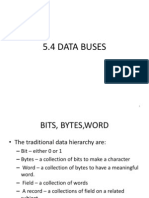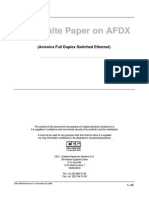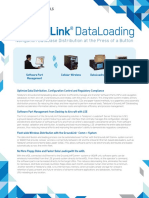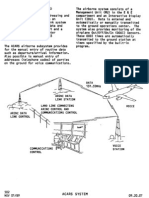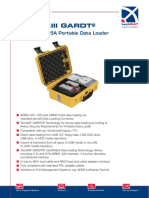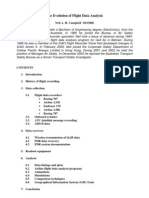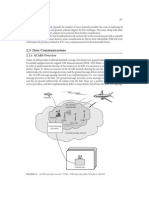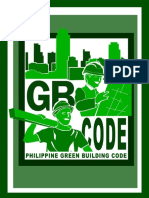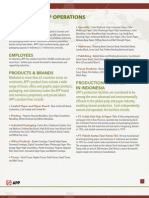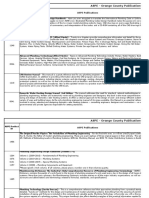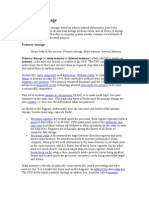Arinc 629
Arinc 629
Uploaded by
ericocheCopyright:
Available Formats
Arinc 629
Arinc 629
Uploaded by
ericocheOriginal Title
Copyright
Available Formats
Share this document
Did you find this document useful?
Is this content inappropriate?
Copyright:
Available Formats
Arinc 629
Arinc 629
Uploaded by
ericocheCopyright:
Available Formats
Recent Researches in Circuits, Systems, Electronics, Control & Signal Processing
ARINC 629 Data Bus Standard on Aircrafts
YASEMIN ISIK
Avionics Department
Anadolu University
Civil Aviation School, 26470, Eskisehir
TURKEY
yaisik@anadolu.edu.tr
Abstract – In earlier analogue avionic systems the number of cables used to transfer information between the various
system components was considerable. With these systems, at least one pair of wires has been required for each signal
and so a typical installation requires several pairs of wires. With the equivalent digital systems, all the analogue signals
are converted into their equivalent and are assigned unique address labels to ensure there are no conflicts. These
signals are then transmitted down a single pair of wires, which makes up a data bus. Aircraft data bus systems allow a
wide variety of avionics equipment to communicate with one another and exchange data. The type of language used on
an aircraft data bus is known as the protocol. There are currently different data bus standards (protocols) that currently
account for most of the avionics data interchange on today’s aircraft, and these are: ARINC 429, ARINC 629, MIL-
STD 1553, MIL-STD 1773, CSDB and ASCB. In this study after evaluating the main characteristics of data
transmission and data bus used aircraft systems, ARINC 629 standard examined in detail.
Key-Words: - Digital data transmission, Aircraft, Aircraft Data bus, Data bus standards, ARINC 629.
1 Introduction Radio Incorporated) data bus standard examined in
The form and interior configuration of aircrafts are detail.
determined by aerodynamic and structural
characteristics. Equipments (or devices) location 2 Data Bus Standards on Aircrafts
therefore weights and dimensions depend on the interior Data transmission is the conveyance of any kind of
configuration of aircraft. However some of the information from one space to another. Historically this
equipments such as inertial navigation systems should be could be done by courier, a chain of bonfires or
installed on some specific locations. This kind of semaphores, and later by Morse code over copper wires.
restrictions can change options in device design. Such as In recent computer terms, it means sending a stream of
devices or equipments can not be located in same place, bits or bytes from one location to another using any
have extensive cabling between each other. Also, some number of technologies, such as copper wire, optical
modernization programs cause some divisions in fiber, laser, radio, or infra-red light [3]. In earlier
equipment locations. All these effects create groups of analogue avionic systems the number of cables used to
equipment communicate each other but different places transfer information between the various system
[1]. components was considerable. With these systems, at
On an aircraft, physical parameters (temperature, least one pair of wires has been required for each signal
pressure, attitude information etc.) and data carried by and so a typical installation requires several pairs of
electromagnetic waves are transmitted to related systems wires. With the equivalent digital systems, all the
after converting electrical signals and processing. analogue signals are converted into their digital
Electrical signals can be analogue or digital forms [2]. equivalent and are assigned unique address labels to
Data transmission methods had developed with the rapid ensure there are no conflicts. These signals are then
development in technology and because of the increase transmitted down a single pair of wires, which makes up
in requirements electronic communication had begun to a data bus. A bus is a collection of wires through which
be insufficient. Using digital data transmission on data is transmitted from one part of a computer to
aircrafts is increased instead of analogue data another. You can think of a bus as a highway on which
transmission. data travels within a computer. When used in reference
In the literature there are severally some studies to personal computers, the term bus usually refers to
about data bus standards for civil and military aircraft. In internal bus. This is a bus that connects all the internal
this study after evaluating the main characteristics of computer components to the CPU (Central Processing
data transmission and data bus used both civil and Unit) and main memory. However when used in
military aircraft systems, ARINC 629 (Aeronautical reference to aircraft, it is the data highway which links
ISBN: 978-960-474-262-2 191
Recent Researches in Circuits, Systems, Electronics, Control & Signal Processing
one computer to another within the aircraft, for example, A bus can enable communication between a single
the FMC (Flight Management Computer) and the ADC computer to a single LRU (Line Replaceable Unit) only,
(Air Data Computer) [4,5]. known as single source-single sink or a single computer
Bus systems provide an efficient means of to multiple LRUs, known as single source-multiple sink,
exchanging data between the diverse avionic systems or multiple computers to multiple LRUs known as
found in a modern aircraft as shown in Figure 1 [6]. multiple source multiple sink. A data bus also classified
All buses consists of two parts an address bus and a on whether or not it can transmit in just one direction it
data bus. The data bus transfers actual data whereas the is termed simplex. If it can transmit in both directions,
address bus transfers information about where the data but not at the same time it is termed half duplex. Where
should go. On an aircraft bus, the two parts are a data bus can transmit in both directions at the same
incorporated within a single data word. time, it is termed full duplex.
A bus can be either serial or parallel. A serial bus The type of language used on an aircraft data bus is
requires less wiring, but is slower. A parallel bus known as the protocol. Main data bus standards that
required one wire for each bit within the data word, but currently account for most of the avionics data
is much faster. Aircraft bus systems use serial data interchange on today’s aircraft, are ARINC 429, ARINC
transfer because it minimizes the size and weight of 629, CSDB (Commercial Serial Digital Bus), ASCB
aircraft cabling. With such a large number of avionic (Avionics Serial Communication Bus) and MIL-STD
systems, a modern aircraft requires a considerable 1553 (Military Standard) [4,5,6].
amount of cabling. Furthermore, some of the cabling
runs in a large aircraft can be quite lengthy. Aircraft
cabling amounts to a significant proportion of the
unladen weight of an aircraft and so minimizing the
amount of cabling and wiring present is an important
consideration in the design of modern aircraft, both civil
and military.
Primary Flight Autopilot Air Data Actuator Control
Computers Director Rreference Unit Electronics
Computers
Flight Control Data Buses
Systems Data Buses
Engine Data
Interface Flap/Slat Proximity
Electronics Unit Electronics Unit
Aircraft Information
Management
System
Fig.1 Multiple bus systems implemented on
modern passenger aircraft
ISBN: 978-960-474-262-2 192
Recent Researches in Circuits, Systems, Electronics, Control & Signal Processing
3 ARINC 629
ARINC is a major company that develops and
A629
operates systems and services to ensure the efficiency,
Bus Bus
operation, and performance of the aviation and travel A B
industries. It was organized in 1929 by four major
airlines to provide a single licensee and coordinator of
radio communications outside the government [7]. It is
now a large international company with headquarters in TERMINAL TERMINAL
Annapolis, Maryland and over 50 operating locations 1 2
worldwide. ARINC has two regional headquarters:
London to serve the Europe, middle East, and Africa
region and Singapore for the Asia Pacific region. The
company has two major thrusts:
Communications and information processing services
for the aviation and travel industry. TERMINAL TERMINAL
3 4
System engineering, development and integration for
government and industry [4,8].
ARINC 629 was introduced in May 1995 and is
currently used on the Boeing 777, Airbus A330 and Data
Bus
Coupler
A340 aircraft. The ARINC 629 bus is a true data bus in Bus
that the bus operates as a multiple-source, multiple sink
system as shown in Figure 2. That is, each terminal can Terminal
transmit data to, and receive data from, every other TERMINAL
Stub
terminal on the data bus. This allows much more 5
freedom in the exchange of data between units in the
avionics system.
The true data bus topology is much more flexible in
that additional units can be fairly readily accepted Multiple-Source
Multiple-Sink
physically on the data bus. A further attractive feature of
ARINC 629 is the ability to accommodate up to a total
of 128 terminals on a data bus shown in Figure 3, though Fig. 2 ARINC 629 Data Bus Topology
in a realistic implementation the high amount of data bus
traffic would probably preclude the use of this large
number of terminals. It supports a data rate of 2 Mbps.
Bus 4
Bus 1 Data
Data
Up to 128
Terminal Terminal
terminals
Terminal Terminal
Subsystems Subsystems
Fig.3 ARINC 629 data bus
ISBN: 978-960-474-262-2 193
Recent Researches in Circuits, Systems, Electronics, Control & Signal Processing
The protocol utilized by ARINC 629 is a time- The ARINC 629 data bus cable consists of an
based, collision-avoidance concept in which each unshielded twisted pair of wires. The wires are #20
terminal is allocated a particular time slot to access the AWG and are bonded together continuously along their
bus and transmit data on to the bus. Each terminal will length. The cables can be up to 100 meters long and
autonomously decide when the appropriate time slot is have no provisions for field splicing. ARINC 629 is
available through the use of several control timers defined for both voltage and current modes of operation.
embedded in the bus interfaces and transmit the One attractive feature of ARINC 629 is that it will be
necessary data. Figure 4 shows the typical ARINC 629 defined for a fiber optic interface ARINC 629 data
20 bit data word format which is very similar toMIL- transmitted in groups called messages. Messages are
STD-1553B. comprised of word strings, up to 31 word strings can be
The first three bits are related to word time in a message. Word strings begin with a label followed
synchronization. The next 16 bits are the data contents, by up to 256 data words. Each label word and data word
and the final bit is a parity bit. The data words may have is 20 bits [4,9,10,11,12,13].
a variety of formats depending on the word function;
there is provision for general formats, systems status,
function status, parameter validity, and binary and
discrete data words.
1 2 3 4 5 6 ……………………………………………………………19 20
Sync Data (depends upon word type) Parity
Fig. 4 ARINC 629 Digital word format
4 Conclusion
Data transmission methods had developed with the References:
rapid development in technology and because of the [1] B. Codur, MIL-STD
increase in requirements electronic communication had 1553,http://www.milscint.com/yazar.asp?yid=6&id=19
begun to be insufficient. Basically electronic (2009)
communication is realized by changing the position of [2] E. Delipınar, ARINC Standardının Bilgisayar
the electrons. So, the factors like the type, structure and Yardımıyla Simülasyonu, 1. Kayseri Havacılık
dimensions of the conductor (copper, etc) that is used Sempozyumu, 223-229, (1996).
affect the speed of the communication. Light is known [3]Data_transmission,
as the most rapid existence in universe. As a result of http://en.wikipedia.org/w/index.php?title= (2009).
investigations, light is begun to use for communication [4] TTS Integrated Training System Module 5, (Digital
besides the sound and electricity. On the aircraft, Techniques Electronic Instrument Systems for EASA
physical parameters (temperature, pressure, position Part-66 Licence Category B1 and B2, Vol1,9-36, 2008.
information) taken from different points and the [5] A. Davies, IR Part-66 Aircraft Maintenance Licence,
information carried with electromagnetic waves are Distance Learning Modules, Module5-Digital
converted into electrical signals is transmitted to the Techniques/Electronic Instrument Systems, Barry
related systems. At this study, after examining the digital College, 2002-2005.
data transmission standards in general and for avionic [6] M. Tooley, Aircraft Digital Electronic and Computer
systems, the usage of them on aircrafts are examined and Systems:Principles, Operation and Maintenance,
ARINC 629 data bus standard is examined in detail. Elseiver, U.SA.,33-44, 2007
[7] ARINC 429 Protocol Tutorial,
ISBN: 978-960-474-262-2 194
Recent Researches in Circuits, Systems, Electronics, Control & Signal Processing
http://www.ecrin.com/downloads/ARINC-429-
tutorial.pdf (2009).
[8] ARINC, http://en.wikipedia.org/wiki/ARINC (2009)
[9] M. Tooley, Aircraft Digital Electronic and Computer
Systems:Principles, Operation and Maintenance,
Elseiver, U.SA.,33-44, 2007.
[10]R.P.G. Collinson, Introduction to Avionics,
Chapman & Hall, London,1996.
[11] I.Moir, A. Seabridge, Civil Avionics Systems,
AIAA, U.S.A, 2003.
[12] A. D. Helfrick, Principles of Avionics, Avionics
Communications, Leesburg, Bt, 2002.
[13] I. Moir, A. Seabridge, Aircraft Systems
mechanical, electrical, and avionics subsystems
integration, AIAA, U.S.A, 2001.
ISBN: 978-960-474-262-2 195
You might also like
- Arinc 717Document2 pagesArinc 717Роман Дяченко0% (1)
- Ima (Ata 42)Document51 pagesIma (Ata 42)Kshitiz Rastogi0% (1)
- Arinc 429Document29 pagesArinc 429xristophorosNo ratings yet
- ARINC Protocol TutorialDocument16 pagesARINC Protocol TutorialFauzan PhoneNo ratings yet
- 5.4 Data BusesDocument29 pages5.4 Data Busesवाईकरांचा लाडका पश्याNo ratings yet
- Avionics Bus - DA - CPDocument25 pagesAvionics Bus - DA - CPM S PrasadNo ratings yet
- Arinc 429 629Document9 pagesArinc 429 629Parthiban A.PNo ratings yet
- Arinc 429Document2 pagesArinc 429Роман ДяченкоNo ratings yet
- CAR 66 Module 5.4 Data BusesDocument24 pagesCAR 66 Module 5.4 Data BusesCdr. Pearl100% (1)
- Fdimu: Flight Data Interface Management Unit Airbus AicraftDocument2 pagesFdimu: Flight Data Interface Management Unit Airbus AicraftBermanBurman YaNo ratings yet
- Airbus Embedded NetworkDocument16 pagesAirbus Embedded NetworkericocheNo ratings yet
- Afdx White PaperDocument20 pagesAfdx White PaperbaburaokodavatiNo ratings yet
- Single Aisle Technical Training Manual T1+T2 (CFM 56) (LVL 2&3) Information SystemsDocument40 pagesSingle Aisle Technical Training Manual T1+T2 (CFM 56) (LVL 2&3) Information Systemssan2inNo ratings yet
- Module 5: Digital Techniques and Electronic Instrument SystemsDocument81 pagesModule 5: Digital Techniques and Electronic Instrument SystemsNaseer AbdaljabarNo ratings yet
- Teledyne GroundLink Dataloading BrochureDocument2 pagesTeledyne GroundLink Dataloading BrochureMinhToànNo ratings yet
- Topic 10 - FMS PDFDocument26 pagesTopic 10 - FMS PDFnjnvsrNo ratings yet
- Avionics-Ae 2401: Unit - 1 Prepared by Rajarajeswari.M Mohammed Sathak Eng CollegeDocument129 pagesAvionics-Ae 2401: Unit - 1 Prepared by Rajarajeswari.M Mohammed Sathak Eng CollegeGaneshVijay0% (1)
- TSN Schneele AFDX 0515 v01 - 2Document31 pagesTSN Schneele AFDX 0515 v01 - 2caportNo ratings yet
- Ethics: Case Study: Boeing 737 Max (Information Current As of June 4, 2019)Document34 pagesEthics: Case Study: Boeing 737 Max (Information Current As of June 4, 2019)Mhmd AlrashedNo ratings yet
- Safram FDIMU Ed48Document2 pagesSafram FDIMU Ed48János RédeiNo ratings yet
- FMS2 Thales/Smiths Improvements: Customer ServicesDocument41 pagesFMS2 Thales/Smiths Improvements: Customer ServicesShimeonNo ratings yet
- Ata 46 Initialization of The ATSU RouterDocument5 pagesAta 46 Initialization of The ATSU RouterSATHYARAJ A/L G. PALANIVELU MBS221080No ratings yet
- Pmat XS: The Compact, Secure, Intuitive DataloaderDocument2 pagesPmat XS: The Compact, Secure, Intuitive DataloaderAbhishek Roy0% (1)
- Arinc - 629Document23 pagesArinc - 629milind71100% (1)
- ACARSDocument42 pagesACARSanticlockwise180100% (3)
- TheAvionicsHandbook Cap 31 PDFDocument16 pagesTheAvionicsHandbook Cap 31 PDFfernandoabel01No ratings yet
- 9-1 - Future ADS-B - PresentationDocument16 pages9-1 - Future ADS-B - PresentationMargaret MeporoNo ratings yet
- Avionics and Aircraft Computer SystemsDocument8 pagesAvionics and Aircraft Computer SystemswalterNo ratings yet
- UG2243800-300 DarDocument21 pagesUG2243800-300 DarРоман ДяченкоNo ratings yet
- ARINC Protocol Tutorial Avionics Bus PDFDocument29 pagesARINC Protocol Tutorial Avionics Bus PDFasterix3679No ratings yet
- Advanced In-Flight Data RecorderDocument6 pagesAdvanced In-Flight Data RecorderueidaqNo ratings yet
- Side Stick & TakeoverDocument21 pagesSide Stick & Takeovermehdi ben hmidaNo ratings yet
- PDL MK - Iii Gardt: ® ARINC 615/615A Portable Data LoaderDocument2 pagesPDL MK - Iii Gardt: ® ARINC 615/615A Portable Data LoaderAbhishek RoyNo ratings yet
- Mod 5 Aircraft Electronics SystemsDocument188 pagesMod 5 Aircraft Electronics SystemsMuhammad Izaimie100% (3)
- 31 36 00002Document16 pages31 36 00002ryan liaoNo ratings yet
- AFDX OverviewDocument12 pagesAFDX OverviewĐặng Đình KhánhNo ratings yet
- ACARSDocument24 pagesACARSVS KRISHNA KUMAR0% (1)
- The Evolution of Flight Data Analysis Neil CampbellDocument22 pagesThe Evolution of Flight Data Analysis Neil CampbellbiniasheNo ratings yet
- Ata 31-Indicating & RecordingDocument36 pagesAta 31-Indicating & RecordingRahul SharmaNo ratings yet
- ARINc 629 PDFDocument9 pagesARINc 629 PDFM S PrasadNo ratings yet
- A319... 321 - Ata 46 - Information System - B2 - eDocument33 pagesA319... 321 - Ata 46 - Information System - B2 - esuper_jaizNo ratings yet
- Soft Afdx (Avionics Full Duplex Switched Ethernet) End System Implementation With Standard PC and Ethernet CardDocument121 pagesSoft Afdx (Avionics Full Duplex Switched Ethernet) End System Implementation With Standard PC and Ethernet CardMarian RotaruNo ratings yet
- Multi Purpose Computer PresentationDocument13 pagesMulti Purpose Computer PresentationLuis Enrique La Font FrancoNo ratings yet
- 2-1 - Introduction To ADS-BDocument19 pages2-1 - Introduction To ADS-BMargaret MeporoNo ratings yet
- 22 Auto FlightDocument92 pages22 Auto FlightShahzreen HowNo ratings yet
- So That Everything Also Works 10000 Meters Above The Ocean: ARINC 629Document2 pagesSo That Everything Also Works 10000 Meters Above The Ocean: ARINC 629Роман ДяченкоNo ratings yet
- Digital Techniques Electrical Instrument Systems: 5.4 Data BusDocument37 pagesDigital Techniques Electrical Instrument Systems: 5.4 Data BusAlexs SolemanNo ratings yet
- ATA 23 - CommunicationsDocument70 pagesATA 23 - CommunicationsQuoc Tan HuynhNo ratings yet
- ADS-B Avionics (Honeywell)Document12 pagesADS-B Avionics (Honeywell)Aidan MonaghanNo ratings yet
- Digital Avionics Handbook, Third Edition PartDocument8 pagesDigital Avionics Handbook, Third Edition Partpaddu_iitmNo ratings yet
- Aerospace Actuators 1: Needs, Reliability and Hydraulic Power SolutionsFrom EverandAerospace Actuators 1: Needs, Reliability and Hydraulic Power SolutionsNo ratings yet
- Aerospace Actuators V3: European Commercial Aircraft and Tiltrotor AircraftFrom EverandAerospace Actuators V3: European Commercial Aircraft and Tiltrotor AircraftNo ratings yet
- Introduction to Fly-by-Wire Flight Control Systems: The professional pilot’s guide to understanding modern aircraft controlsFrom EverandIntroduction to Fly-by-Wire Flight Control Systems: The professional pilot’s guide to understanding modern aircraft controlsNo ratings yet
- Integrated Modular AvionicsDocument20 pagesIntegrated Modular Avionicsame_ravisingh100% (1)
- Radio Navigation Maintenance ProceduresDocument4 pagesRadio Navigation Maintenance Proceduresame_ravisinghNo ratings yet
- ITP031 ELH Master Copy - Pavement DrainsDocument3 pagesITP031 ELH Master Copy - Pavement DrainsshazniSNo ratings yet
- Philippine Green Building CodeDocument64 pagesPhilippine Green Building CodeTina Cruz100% (1)
- Contoh Cover LetterDocument1 pageContoh Cover LetterIzzat Hanif100% (1)
- APP Operations Fact SheetDocument2 pagesAPP Operations Fact SheetAsia Pulp and PaperNo ratings yet
- SikaTop Seal-107 PDFDocument4 pagesSikaTop Seal-107 PDFDan BermasNo ratings yet
- Gener. Inverter - KGE2000TiDocument2 pagesGener. Inverter - KGE2000TiManuel Sierra100% (1)
- Member ASPE Publications Order Form PDFDocument10 pagesMember ASPE Publications Order Form PDFAbdul JamalNo ratings yet
- Repair Concrete Slab Cracks / Settlement DamageDocument16 pagesRepair Concrete Slab Cracks / Settlement DamageEvello MercanoNo ratings yet
- Installation Manual - LG AC EnglishDocument33 pagesInstallation Manual - LG AC EnglishDennis S.No ratings yet
- Honda PricesDocument7 pagesHonda Pricesmuhammad nazirNo ratings yet
- Types of Piles Load Tests: Proof-TestDocument13 pagesTypes of Piles Load Tests: Proof-Testkaranbir123No ratings yet
- Lennox Unit Heater Brochure - UnlockedDocument6 pagesLennox Unit Heater Brochure - Unlockede-ComfortUSANo ratings yet
- Engine: QSB3.3-C99 Machine: AP240 Tier 3 Specification: Z07-620-2Document60 pagesEngine: QSB3.3-C99 Machine: AP240 Tier 3 Specification: Z07-620-2abelmonte_geotecnia67% (3)
- 2g SunroofDocument9 pages2g SunroofBud HetrickNo ratings yet
- 7000 Process Safety System T2Document150 pages7000 Process Safety System T2Gee Fung100% (2)
- Cover Letter For Taj QuotationDocument4 pagesCover Letter For Taj Quotationneer10No ratings yet
- Catalogue - New QPF PDFDocument32 pagesCatalogue - New QPF PDFShaiju EbrahimNo ratings yet
- Flat BeltDocument12 pagesFlat BeltMarcos Suarez100% (1)
- Royu Electrical Devices Price List PDFDocument8 pagesRoyu Electrical Devices Price List PDFFrederick Ulanday0% (1)
- Cummins QSB5!9!305 PerfDocument3 pagesCummins QSB5!9!305 PerfVăn Tuấn NguyễnNo ratings yet
- Intergraph Smart 3D Virtual Training PDFDocument2 pagesIntergraph Smart 3D Virtual Training PDFAleksandr KorshunovNo ratings yet
- Neptune PZ ManualDocument56 pagesNeptune PZ ManualCGFernandez2014100% (1)
- Emax CAD Step Cerec-E - 627931Document2 pagesEmax CAD Step Cerec-E - 627931Leo JamesNo ratings yet
- Transmission Grandis PDFDocument151 pagesTransmission Grandis PDFShimmer CrossbonesNo ratings yet
- Purpose of StorageDocument3 pagesPurpose of StorageAshish MacNo ratings yet
- JPT RevistaDocument84 pagesJPT Revistaabraham dominguezNo ratings yet
- AGC - Asahi Glass Overview - 31 July 06Document19 pagesAGC - Asahi Glass Overview - 31 July 06api-3709410No ratings yet
- Convertidor de Par y Toma de FuerzaDocument19 pagesConvertidor de Par y Toma de FuerzaDimitri IanNo ratings yet
- Brosur Koolroof 750Document6 pagesBrosur Koolroof 750indra pramudiaNo ratings yet
- I Have Ordered An Injection Kit For GY6 Engines. It's From Ecotrons in Detroit, USADocument12 pagesI Have Ordered An Injection Kit For GY6 Engines. It's From Ecotrons in Detroit, USAAssem AhmedNo ratings yet









